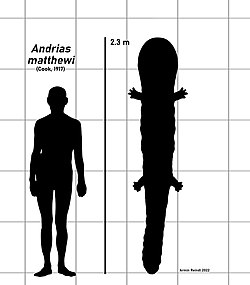Biology:Andrias matthewi
| Andrias matthewi | |
|---|---|

| |
| Size comparison between a human and A. matthewi | |
| Scientific classification | |
| Domain: | Eukaryota |
| Kingdom: | Animalia |
| Phylum: | Chordata |
| Class: | Amphibia |
| Order: | Urodela |
| Family: | Cryptobranchidae |
| Genus: | Andrias |
| Species: | †A. matthewi
|
| Binomial name | |
| †Andrias matthewi (Cook, 1917)[2]
| |
| Synonyms | |
| |
Andrias matthewi, or Matthew's giant salamander,[4] is an extinct species of giant salamander from the Miocene of North America. It belongs to the genus Andrias, which contains the living Asian giant salamanders. It is the largest salamander to have ever existed, with a maximum estimated length of 2.3 m (7 ft 7 in).[5] Its fossils have been found in Nebraska, Colorado, and Saskatchewan.[1]
Taxonomy
In 1917, Harold Cook named the new genus and species Plicagnathus matthewi for a dentary from the "lower Snake Creek beds"[lower-alpha 1] of Nebraska.[2] The species was named in honor of William Diller Matthew, who first identified the specimen.[2] In 1963, Joseph Tihen and Charles Chantell named the new species Cryptobranchus mccalli for two maxillae from the Valentine Formation of Nebraska.[3] Charles Meszoely synonymized C. mccalli with P. matthewi and Plicagnathus with Andrias in 1966, leading to the current name Andrias matthewi.[7] Bruce Naylor synonymized Andrias with Cryptobranchus in 1981, resulting in the combination Cryptobranchus matthewi,[5] but this was not accepted by subsequent authors.[1]
Size
Cook estimated a length of 1.52 m (5 ft 0 in) based on the holotype dentary.[2] Meszoely estimated lengths of 1.5 m (4 ft 11 in) and 1.8 m (5 ft 11 in) from a referred maxilla and dentary, respectively, from the Marsland Formation of Nebraska.[7] Naylor estimated a length of 2.3 m (7 ft 7 in) using two vertebrae from the Wood Mountain Formation of Saskatchewan.[5] In comparison, the largest living salamander, the South China giant salamander (Andrias sligoi), reaches lengths of 1.75 m (5 ft 9 in).[8]
Notes
- ↑ This unit was later renamed to the Olcott Formation.[6]
References
- ↑ 1.0 1.1 1.2 Holman, J.A. (2006). Fossil Salamanders of North America. Bloomington, IN: Indiana University Press. pp. 71–73. ISBN 0-253-34732-7. https://books.google.com/books?id=jedqR3axP_MC.
- ↑ 2.0 2.1 2.2 2.3 Cook, H.J. (1917). "First recorded amphibian from the Tertiary of Nebraska". Bulletin of the Geological Society of America 28: 213. https://www.biodiversitylibrary.org/item/111862#page/253/mode/1up.
- ↑ 3.0 3.1 Tihen, J.A.; Chantell, C.J. (1963). "Urodele remains from the Valentine Formation of Nebraska". Copeia 1963 (3): 505-510. doi:10.2307/1441470. https://www.jstor.org/stable/1441470.
- ↑ Holman, J.A. (1976). "The herpetofauna of the lower Valentine Formation, north-central Nebraska". Herpetologica 32 (3): 262–268. https://www.jstor.org/stable/3891452.
- ↑ 5.0 5.1 5.2 Naylor, B.G. (1981). "Cryptobranchid salamanders from the Paleocene and Miocene of Saskatchewan". Copeia 1981 (1): 76–86. doi:10.2307/1444042. https://www.jstor.org/stable/1444042.
- ↑ Skinner, M.F.; Skinner, S.M.; Gooris, R.J. (1977). "Stratigraphy and biostratigraphy of late Cenozoic deposits in central Sioux County, western Nebraska". Bulletin of the American Museum of Natural History 158 (5): 263-370. https://digitallibrary.amnh.org/handle/2246/1233.
- ↑ 7.0 7.1 Meszoely, C. (1966). "North American fossil cryptobranchid salamanders". The American Midland Naturalist 75 (2): 495–515. doi:10.2307/2423407. https://www.jstor.org/stable/2423407.
- ↑ Turvey, S.T.; Marr, M.M.; Barnes, I.; Brace, S.; Tapley, B.; Murphy, R.W.; Zhao, E.; Cunningham, A.A. (2019). "Historical museum collections clarify the evolutionary history of cryptic species radiation in the world's largest amphibians". Ecology and Evolution 9 (18): 10070–10084. doi:10.1002/ece3.5257.
Wikidata ☰ Q113647995 entry
 |

